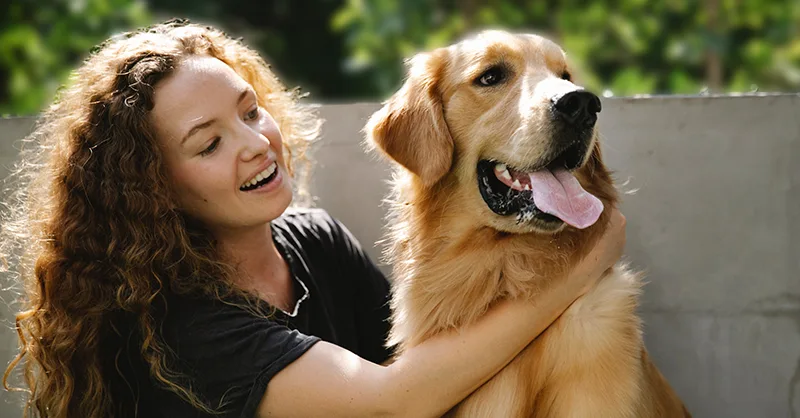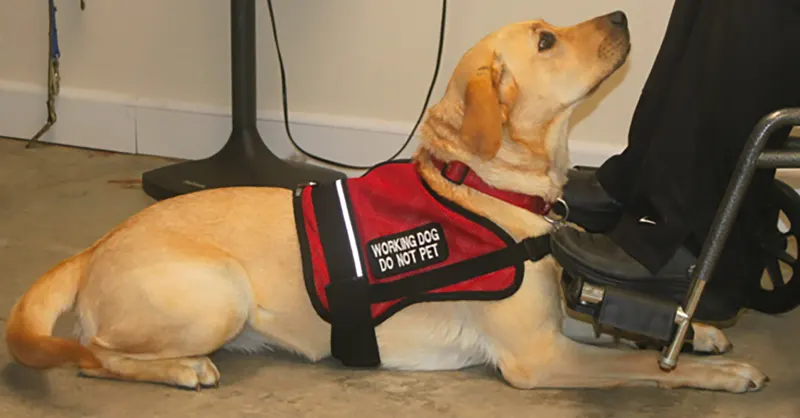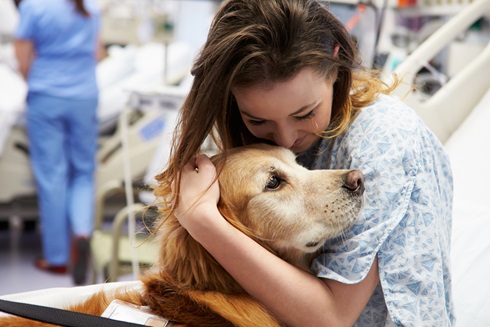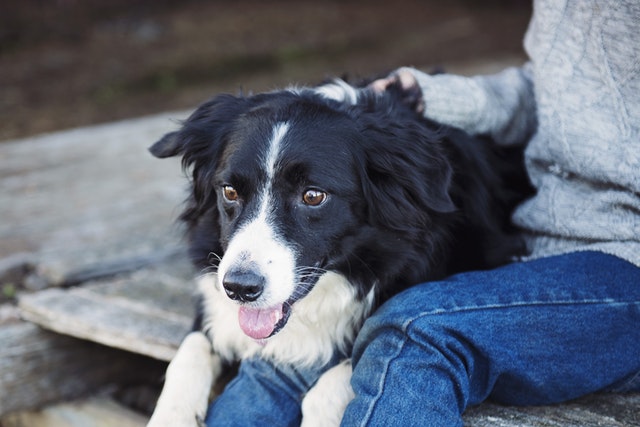Archive for the ‘News’ Category
Alert dogs are best known for guiding the visually impaired, sniffing out drugs and bombs, or providing mobility assistance for people with severe disabilities. Diabetic Service Dogs, or DSDs for short, are service dogs trained to detect hypoglycemia and alert their owners to treat it while they are still conscious and aware. The ADA, or the American Disability Association, considers this to be a type of service dog because diabetes is a type of disability. DSDs detect low blood sugar through organic compounds in the person’s breath and are trained to respond to these changes in blood sugar. Whether the individual has Type I, Type II, or hypoglycemia unawareness, DSDs can react to these changes in compounds and alert the owner to act.
What services do Diabetic Service Dogs provide?While the primary objective of a DSD is to notify their owner of any changes to their blood sugar levels, they also provide other ways of service that come with a service animal, such as:
A Sense of Comfort for the Owner Increased Physical Activity Improved Regulation of Blood Sugar Levels Increased Socialization and Independence A Sense of Ease for Family MembersDSDs can also be used as a medical expense. As long as the owner’s disability is legally recognized, the costs of buying, training and maintaining the owner’s service dog can count towards their tax assessments. While DSDs provide companionship, DSDs cannot be the only reliable source for people to check their blood sugar. Owners of DSDs should not rely entirely on their service animals and should check their glucose monitors for their levels and take extra precaution when dealing with their health.
Diabetic Service Dogs can notify their owners when blood sugar levels change. How do trainers train a Diabetic Service Dog?Training varies depending on the organization or trainer. Diabetic Service Dogs are trained from birth until they are around 18 months old, beginning with training in public access and social conditioning to help to expose them to various environments, including scents, objects, and sounds. From there, trainers work the dogs towards the next step, scent detection work. In the case for DSDs, these dogs are trained to detect the hypoglycemic scent, obtained from a person with diabetes while their blood sugar level is below 70. These dogs are then tested under the Assistance Dogs International (ADI) public access test, which follows through a series of objectives to evaluate the dog’s behavior in distracting environments. For owners who wish to train their dogs, they should partner with a trainer experienced in training service dogs and follows the ADA guidelines.
How accurate are Diabetic Service Dogs at detecting low blood sugar?Dogs are known to have a great ability to smell. This ability to detect smell is based on the number of olfactory cells they have. Compared to humans, who have 5 million olfactory cells, dogs have up to 220 million olfactory cells. This means that a dogs nose can be 1,000 times more sensitive than a human. In practice, DSDs alert their owners by recognizing a scent emitted when that diabetics blood sugar begins to drop rapidly. However, the accuracy of the dog’s ability to smell that scent or what precisely the smell is is up to debate by many researchers. According to studies, results vary, with some stating that the dog’s ability isn’t as accurate and others stating the opposite. Hence, the standards for what accounts as a precise sense of smell for DSDs is currently unavailable and is still being determined.
How to register your Diabetic Service DogBecause the ADA does not directly support service dog registration, it is essential to find the right organization to register your service dog. The right Service Dog Certifications and Registry will provide support for service dog owners. By ordering a custom identification card for you and your Service Dog, you help others follow the guidelines set out by the ADA and helps store employees grant public access to you even if they have a no-pet policy. It is important to work with a trustworthy source so you can direct store employees to the right resource as well. Service Dog Certifications, however, does not train or provide assistance dogs for people with disabilities. Instead, they recommend adopting a service dog and working with a trainer if you have the means. If that is not possible, no worries, you can absolutely still adopt a service dog and train them yourself or seek support from a local trainer.
Some tips on choosing the right organization/trainer include:
Don’t get a dog from a trainer or organization that will not allow you to visit the training facility Ask the trainer about follow-up support Ask for test demonstrations for the puppy as you would with an adult dog Ask for health records, demand to see the kennel and parents of the pup. Ask about scent imprint procedures and exactly how the trainers teach their dogs to imprint. After purchasing your new DSD, get a health evaluation from your vet: Hip x-ray, routine blood tests, heartworm snap.According to the U.S. Department of Justice, the Service Animal is defined as a dog that is specifically trained to perform a task (or tasks) for an individual with a disability.
With this definition in mind, a Service Dog is not an ordinary pet or even one that is being used for emotional support (ESA).
In this post, we will take a more in-depth look at this topic to uncover what makes a Service Dog legal.
A Service Dog is NOT an Emotional Support AnimalThere may be some confusion as to the difference between a Service Dog and an Emotional Support Animal. As we mentioned earlier, the Service Dog must be specifically trained to perform a task that the person cannot do for themselves.
This includes (but is not limited to);
Guiding the blind Pulling a wheelchair Opening doors Alerting to an oncoming medical condition Reminding the individual to take medications Alerting those with hearing impairmentsAn Emotional Support Animal is defined as any animal that is being used by an individual with a mental or emotional disability for comfort. This can include helping people with social anxieties, PTSD, phobias, anxiety, and depression. Unlike a Service Dog, an ESA is not specifically trained for providing a task(s) for their owner.
Unlike an Emotional Support Animal, Service Dogs are allowed into all areas where the general public has a right to go. This includes restaurants, hotels, theaters, public transportation, libraries, retail outlets, malls, etc.
Difference between service dog, emotional support dogs, and therapy dogs
How Do I Qualify for a Service Dog?Before you can have a legitimate Service Dog, you must have a disability that requires the assistance of a canine companion. Some disabilities are obvious and therefore will need no explanation for the dog. Other conditions may not be so visible, but that doesn’t mean you are not entitled to having one.
The Americans With Disabilities Act (ADA) does have a clear definition as to what is considered disabled. If you are unsure, ask your doctor if you may qualify for a Service Dog.
To register your dog and get your service dog ID card, please complete the registration below.
What Makes a Service Dog Legal?Training of the Service Dog to perform a specific task is key to it being legitimate. According to the ADA, the Service Dog does not need to be professionally trained, meaning the disabled individual may go through this process themselves.
However, be aware that the handler of the dog is 100% responsible for that canine in all situations. The Service Dog must be under your control at all times. It cannot exhibit any unruly behavior such as jumping, begging, wandering off, barking, lunging at people, etc.
The ADA also does not consider a Service Dog in training a full-fledged assistance animal, so it is not yet allowed into those public areas that are normally off limits to dogs.
The Service Dog is also not legally required to wear any identification of its status; however, having a specifically marked vest, harness or badge will make it easier when you are dealing with the general public.
What Questions Can Be Asked of Me?In situations where your disability may not be obvious, there are only two questions that may be asked of you;
Is the dog a service animal required because of a disability? What work or task has the dog been trained to perform?Note: The staff are not allowed to request any documentation for the dog, require that the dog demonstrate its task, or inquire about the nature of your disability.
You and Your Service DogIf you have a disability and need the help of a Service Dog, know your rights. You are allowed to have this working animal with you in all areas open to the general public. However, your dog must be well behaved and in your control at all times. If your disability is not openly visible, staff members are only legally able to ask you two questions in regards to your Service Dog.
Don’t suffer another minute when a Service Dog may be the answer to getting you back on the road to living a more productive, normal life.
We’ve probably all seen a service dog helping to guide a person that is physically challenged but did you know you can also have a service dog if you suffer from anxiety?
Dogs can be especially helpful to those that suffer from any number of mental or emotional issues such as PTSD or social anxiety. However, unlike a service dog that has been trained by professionals to work with their owner, you can train your own dog to help you cope with your emotional trauma. Here are some basic steps on how to train a service dog for anxiety.
Step #1 – Choosing the Right Service DogIt is highly recommended to start out with the right breed for being a service dog. Some canines just do not exhibit the right temperament to do this important and demanding job.
To ensure you are getting a pup that can be trained for service, it’s advised to look to those reputable breeders that are raising dogs for this specific purpose. You can also find great service dog candidates at your local shelters too!
According to Psychiatric Service Dog Partners when choosing a puppy for service work, look for these qualities;
Social – quick to greet Does not startle easily Follows Eager to be held Alert Step #2 – Determine the Service Dog’s JobOnce you have your puppy you must determine what you will need the dog to do for you in order to guide its training. Once this is established you can begin bonding with your puppy. This helps create a baseline for your dog to recognize when you are in a relaxed state and when you are beginning to experience anxiety – dogs are very intuitive so the right dog will pick up on this naturally.
Step #3 – Develop Socialization SkillsReputable breeders will have already started the socialization process with their puppies. This means the puppy has been handled extensively, been introduced to new people and new situations as well as being taken outside of the home.
When you get your puppy, it’s important that you keep up the socialization. The last thing you want is a dog that is frightened or stressed each time it encounters something new.
Step #4 – Start Basic Training SkillsAll dogs should have the basics of training and good behavior, but it is doubly important if you plan to bring your dog with you into public areas. These skills include;
Sit Stay Drop Heel Leave ComeIf you feel you cannot teach your canine companion the basic obedience skills needed, then enlist the help of a professional trainer. These people have the knowledge to, not only teach your dog, but also teach you how to continue the training outside of the weekly sessions.
Step #5 – Fine Tune Public Access SkillsOnce your service dog-in-training has mastered his/her basic commands, then you can begin to work on public access skills. Use those pet-friendly areas like retail pet stores, outdoor cafes etc. to help your dog become accustomed to the hustle and bustle of public places.
Step #6 – Individual Response TrainingIt may be difficult to train a dog to alert a person before a panic attack, but with a close bond, your dog may pick up on your different body language and, if you are completely fear-stricken, the chemical changes in your body.
Some people who suffer from anxiety and stress have reported that giving the puppy/dog a treat when they are experiencing the symptoms is a helpful way to teach your dog to respond; however, not everyone is capable of this type of action when in the midst of anxiety, stress or fear.
Cuddling your dog close when you feel stressed is not only a great way to help bring relief to you, but will also allow the dog the chance to pick up on your “tell” signs. This is why it is crucial to find the right breed and/or temperament of your canine service dog.
Training a Service Dog for AnxietyWhen training a service dog for anxiety you will have to have patience and persistence, especially with puppies. Begin with the basic training skills and socialization, then work your dog up for public access. Having a dog that helps with severe anxiety, PTSD, panic attacks and so on is a therapeutic way to get your life back on track.







